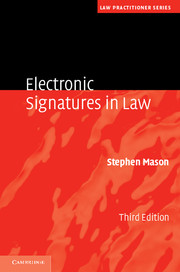Book contents
- Frontmatter
- Contents
- Preface
- Acknowledgements
- Table of cases
- 1 The signature
- 2 International initiatives
- 3 European Union Directive on electronic signatures
- 4 England and Wales, Northern Ireland and Scotland
- 5 International comparison of electronic signature laws
- 6 The form of an electronic signature
- 7 Digital signatures
- 8 Liability
- 9 Evidence
- 10 Data protection
- Index
- References
7 - Digital signatures
- Frontmatter
- Contents
- Preface
- Acknowledgements
- Table of cases
- 1 The signature
- 2 International initiatives
- 3 European Union Directive on electronic signatures
- 4 England and Wales, Northern Ireland and Scotland
- 5 International comparison of electronic signature laws
- 6 The form of an electronic signature
- 7 Digital signatures
- 8 Liability
- 9 Evidence
- 10 Data protection
- Index
- References
Summary
Technical overview of digital signatures
Cryptography is the method of hiding the contents of a message, used from ancient times to the present. Encryption (or enciphering) is the process by which a plaintext (or cleartext) message is disguised sufficiently to hide the substance of the content. As well as ordinary text, a plaintext message can be a stream of binary digits, a text file, a bitmap, a recording of sound in digital format, audio images of a video or film and any other information formed into digital bits. When a message has been encrypted, it is known as ciphertext or a cryptogram. The opposite procedure, that of turning the ciphertext back into plaintext, is called decryption (or deciphering). In essence, contemporary cryptographic systems change one set of symbols that have meaning (binary data) into a second set of symbols that has no meaning, by means of a mathematical process. Cryptography is usually required to undertake a number of functions, the most important of which is authenticity, rather than secrecy. These functions are discussed below.
Authenticity
To ensure the authenticity of the information. When sending or receiving information or placing an order, both parties need to have assurance of the origin of the message. The aim is to corroborate the identity of the entity that sent the data, such as the computer (the identity of a person cannot be corroborated, because a person is not part of the communications process – the process only involves computers).
- Type
- Chapter
- Information
- Electronic Signatures in Law , pp. 259 - 302Publisher: Cambridge University PressPrint publication year: 2012
References
- 1
- Cited by

